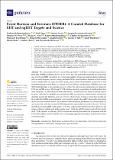| dc.contributor.author | Ramakrishnan, Venkatessh | |
| dc.contributor.author | Nagar, Neil | |
| dc.contributor.author | Arratia, Vicente | |
| dc.contributor.author | Hernández-Yévenes, Joaquín | |
| dc.contributor.author | Pesce, Dominic W. | |
| dc.contributor.author | Nair, Dhanya G. | |
| dc.contributor.author | Bandyopadhyay, Bidisha | |
| dc.contributor.author | Medina-Porcile, Catalina | |
| dc.contributor.author | Krichbaum, Thomas P. | |
| dc.contributor.author | Doeleman, Sheperd | |
| dc.contributor.author | Ricarte, Angelo | |
| dc.contributor.author | Fish, Vincent L. | |
| dc.contributor.author | Blackburn, Lindy | |
| dc.contributor.author | Falcke, Heino | |
| dc.contributor.author | Bower, Geoffrey | |
| dc.contributor.author | Natarajan, Priyamvada | |
| dc.date.accessioned | 2023-01-20T15:47:17Z | |
| dc.date.available | 2023-01-20T15:47:17Z | |
| dc.date.issued | 2023-01-12 | |
| dc.identifier.uri | https://hdl.handle.net/1721.1/147602 | |
| dc.description.abstract | The next generation Event Horizon Telescope (ngEHT) will observe multiple supermassive black hole (SMBH) candidates down to a few tens of mJy, and profoundly transform our understanding of the local SMBH population. Given the impossibility of large-area high-resolution millimeter surveys, multi-frequency spectral energy densities (SEDs), and models are required to both identify source samples tailored to specific science goals, and to predict the feasibility of detection of individual interesting sources. Here, we present the Event Horizon and Environs (ETHER) source and SED model database whose primary use is to enable the selection and optimization of targets for EHT and ngEHT science. The living ETHER database currently consolidates 1.6 million black hole mass estimates, ∼15,500 milliarcsec-scale radio fluxes, ∼14,000 hard X-ray fluxes (expected to grow by factor ≳40 with the eROSITA data release) and SED information as obtained from catalogs and database queries, the literature, and our own new observations. Jet and accretion flow models are fit to individual SEDs in an automated way in order to predict the ngEHT observable fluxes from the jet base and accretion inflow. The database can be filtered by parameters or cross matched to a user source list, with the automated SED fitting models optionally fine tuned by the user. We have identified an initial ngEHT ‘gold sample’ for jet base studies and potentially black hole shadows; this sample will grow significantly in the coming years. While the ngEHT requires and will best exploit the ETHER database, six (eleven) ETHER sources have already been observed (scheduled) with the EHT in 2022 (2023), and the database has wide ranging applications in galaxy and black hole mass evolution studies. | en_US |
| dc.publisher | Multidisciplinary Digital Publishing Institute | en_US |
| dc.relation.isversionof | http://dx.doi.org/10.3390/galaxies11010015 | en_US |
| dc.rights | Creative Commons Attribution | en_US |
| dc.rights.uri | https://creativecommons.org/licenses/by/4.0/ | en_US |
| dc.source | Multidisciplinary Digital Publishing Institute | en_US |
| dc.title | Event Horizon and Environs (ETHER): A Curated Database for EHT and ngEHT Targets and Science | en_US |
| dc.type | Article | en_US |
| dc.identifier.citation | Galaxies 11 (1): 15 (2023) | en_US |
| dc.contributor.department | Haystack Observatory | |
| dc.identifier.mitlicense | PUBLISHER_CC | |
| dc.eprint.version | Final published version | en_US |
| dc.type.uri | http://purl.org/eprint/type/JournalArticle | en_US |
| eprint.status | http://purl.org/eprint/status/PeerReviewed | en_US |
| dc.date.updated | 2023-01-20T14:23:02Z | |
| dspace.date.submission | 2023-01-20T14:23:02Z | |
| mit.license | PUBLISHER_CC | |
| mit.metadata.status | Authority Work and Publication Information Needed | en_US |
